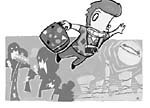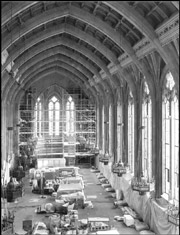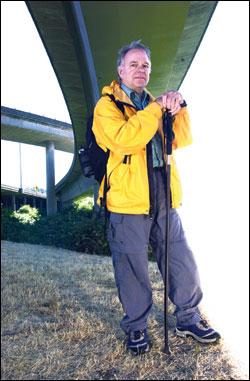LET’S OUT THE AWFUL truth right up front: It rains in the Southwest. Not much and not often, but it rains—and with perverse irony, it’ll probably pour just as you touch down in Tucson or Albuquerque for your winter respite from suddenly sunny Seattle.
What’s different down there are the consequences of the rain. It doesn’t nag exposed wood into rot, doesn’t make moss overrun driveways, doesn’t spike Prozac sales. In the Southwest rain usually inspires rejoicing. Evanescent waterfalls tumble into desert canyons, spidery ocotillo fire off flamelike flowers, and the desert’s big cities—Las Vegas, Phoenix, Tucson, Albuquerque, El Paso—win another reprieve against the day when their water expires for good and they’re abandoned to the ghosts and rattlers.
That said, here are seven Southwestern destinations for consideration. Don’t take your Gore-Tex. You might actually need it, but you’d look like a doofus.
Sedona, Az. In a perfect world, Teddy Roosevelt would have roped off a Sedona National Park 90 years ago as a companion to the Grand Canyon, saying of Sedona what he said of the canyon: “Leave it the hell alone.” Instead Sedona has been left to the wisdom of private enterprise, which has scraped, gouged, and littered the red rock ridges with increasingly pretentious houses. But there’s still a lot of landscape left, a giant’s fantasy chess set of salmon-colored mountains, buttes, spires, and canyons. Winter brings fewer tourists and the occasional tease of fog and snow—either of which shift the landscape from merely magical to otherworldly. Average December high: 56. Low: 31. Annual precipitation: 17.2 inches.
Tucson, Az. The sprawling city has never won an enlightened-planning prize, but it’s one of North America’s great hiking destinations, especially in winter. The four surrounding mountain ranges poke up to 9,453 feet into the Sonoran Desert sky, and some of the trails climb through four or five distinct biological zones. Most of their residents will either stick you, sting you, or bite you, so be careful out there. Tucson’s two essential man-made attractions are the Arizona-Sonora Desert Museum, a superb zoo/arboretum; and the manic-baroque Spanish mission of San Xavier del Bac. Average December high: 66. Low: 43. Annual precipitation: 12.0 inches.
Cochise County, Az. You could spend a week getting to know this quirky and beautiful southeastern corner of the state. In Bisbee—a sort of desert Port Townsend—rickety Italianate Victorian architecture clings hopefully to the slopes of a canyon; good B&Bs, unpredictable galleries, and leftover hippies busily qualifying for AARP cards now inhabit this retired mining town. Kids and Japanese tourists love Tombstone, site of the famous shootout at the OK Corral. More inspiring and much less crowded is Chiricahua National Monument, a mountain range bristling with erosion-sculpted volcanic hoodoos resembling ducks, gnomes, and gothic turrets. Washingtonians will feel right at home—the remote Chiricahuas are lousy with black bears. Bisbee average December high: 60. Low: 35. Annual precipitation: 16.2 inches.
Moab, Ut. Here Edward Abbey began Desert Solitaire, the touchstone of Southwestern guerrilla nature literature. Abbey called it the most beautiful place on earth, a portal into a reawakened awareness of the wonderful. No, not the town of Moab, but the red sand desert and slickrock country just north of it, especially Arches National Park. More than 1,500 natural sandstone arches curl through the sky here, nearly all of them demanding some footwork to visit—this park doesn’t coddle visitors. Moab is also the world’s nerve center of mountain biking, with challenges that can scare the Lycra off even the boldest bikers. Average December high: 45. Low: 21. Annual precipitation: 9.1 inches.
Chaco Canyon, NM. Strange and possibly unspeakable things happened here 900 years ago. This was the ceremonial and political capital of a Puebloan culture that built vast apartment blocks up to five stories high with 800 rooms. Even in ruins they’re awesome. And inexplicable: This dry, desolate canyon could not possibly have supported the population its architecture suggests. Last year maverick archaeologist Christy Turner published an explosive book detailing his 30-year investigation into cannibalism in the Chaco culture, concluding that yes, They Did It. Some modern visitors have had spooky experiences here; don’t hang around after dark. Average December high: 43. Low: 12. Annual precipitation: 10.5 inches.
Taos, NM. This isn’t a junior version of Santa Fe, it’s an intriguing stew of cheesy commercial squalor (no fewer than four T-shirt shops surround the Plaza), high art, and serious economic struggle within the Hispanic native population, whose ancestors farmed their chiles and apples for 300 years before the gringos started jacking up land valuations. Attractions include some 80 art galleries, the famously photogenic Rancho de Taos church (it convinced Ansel Adams to become a photographer instead of a pianist), Taos Pueblo, advanced-placement skiing on 13,161-foot Taos Mountain, and the stunning new Ridhwan Sculpture Garden. Expect cold, maybe snow, but not gloom: Even in the dead of winter, Taos’ light is inspirational. Average December high: 43. Low: 12. Annual precipitation: 12.1 inches.
Albuquerque, NM. This city has few pretensions, which makes it a cooler desert destination than Las Vegas or Phoenix— in character as well as climate. It’s a reasonably priced home base for day trips radiating north and west, such as Santa Fe (50 miles), the Jemez Mountains (70 miles), and Acoma Pueblo (70 miles). Albuquerque’s cultural center of gravity is Hispanic, and its most accessible component is New Mexican cuisine. Forget Tex-Mex, Nuevo California, and all other permutations—this is the right stuff. A New Mexican chef blends chile varieties as artfully as a French vintner mixes grapes, and the result is just as intoxicating. Even the airport has good enchiladas, which shows just how seriously New Mexicans take their birthright. Average December high: 48. Low: 23. Annual precipitation: 8.9 inches.







